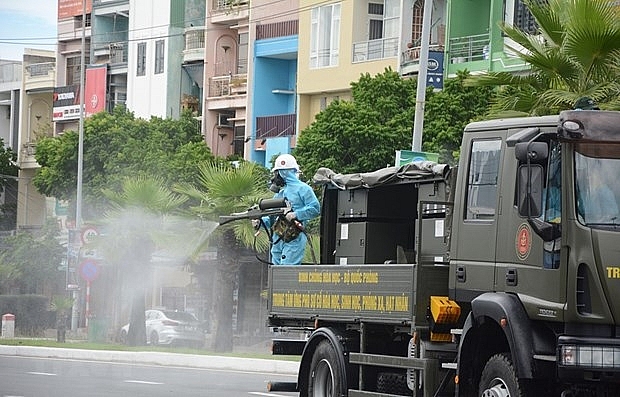Rebound likely despite bumpy roads
 |
| Spraying disinfectant in Danang. Photo: VNA |
According to the World Bank, Vietnam’s economy has been hurt but remains resilient even during the COVID-19 pandemic which is expected to result in global GDP growth of 5.2 per cent.
“Although the Vietnamese economy suffered from COVID-19 in the first half of 2020, prospects remain positive for both the short and medium term,” read the bank’s updated Taking Stock report released last week.
Assuming a gradual improvement in the world economy, GDP should rebound in the second half so the economy would grow around 2.8 per cent for the entire year. It should expand by 6.8 per cent in 2021 (baseline scenario). With less favourable external conditions, the economy will expand by only 1.5 per cent in 2020 and 4.5 per cent in 2021 (downside scenario).
“Regardless of scenario, Vietnam is expected to remain one of the fastest-growing economies in the world in 2020. This projected performance means that Vietnam would be the fifth-fastest growing country in the world in 2020,” said Stefanie Stallmeister, acting country director of the World Bank in Vietnam.
The bank explained that the COVID-19 health shock has forced governments around the world to make hard choices between saving lives and limiting economic restrictions. While many countries hesitated in their decisions, Vietnam was quick and bold to react. The combination of early measures – targeted testing and tracking, as well as innovative information campaigns – have proved highly effective.
Citing the same reasons, global data analyst FocusEconomics told VIR in a statement that Vietnam’s economic growth is expected to slow notably this year on weaker exports and lower tourist arrivals.
“However, Vietnam should still be by far the strongest performer in the ASEAN, thanks in part to a rapid resumption of domestic activity,” said the statement. “Risks to the outlook stem from a possible domestic flare-up in cases if borders are reopened, and a potentially weak recovery in external demand. FocusEconomics panellists project the economy will expand 2.7 per cent in 2020 and 7.6 per cent in 2021.”
“While Vietnam has been highly lauded for its disciplined handling of the COVID-19 pandemic, the external environment is far more difficult to overcome. Concerns about a second wave of infections continue to plague Vietnam’s key markets of the United States and, to a certain extent, Europe, making demand recovery a great uncertainty,” it said.
According to Deputy Minister of Planning and Investment Tran Quoc Phuong, it is expected that the domestic economy will continue facing massive difficulties because it is quite open to the global economy. “Given complications in the world economy amidst the raging pandemic, it is difficult to come up with an accurate forecast for the country’s economic growth this year, especially as numerous difficulties continue to beset local production,” he said.
The General Statistics Office (GSO) last week released statistics on Vietnam’s seven-month official production-related figures.
“The index for industrial production (IIP) continued facing difficulties, with July IIP increasing only 3.6 per cent on-month and 1.1 per cent on-year, falling short of a breakthrough climb like the one in June [up 10.3 per cent on-month and 7.2 per cent on-year],” the GSO said in a report. “In the first seven months, the IIP ascended 2.6 per cent on-year, far lower than the 9.4 per cent in the same period last year, and also the lowest level of increase over the past many years.”
The key reason for the murky waters throwing off economic forecasts and ailing performance is the unchecked spread of COVID-19 globally, hurting all input material supply chains.
The Central Institute for Economic Management, the government’s leading think-tank under the Ministry of Planning and Investment, has also released two scenarios on Vietnam’s economic growth for this year, based on analysis of the poor global economic performance and the health of the domestic economy which grew by only 1.81 per cent – the lowest six-month rate over the past 12 years.
Accordingly, the Vietnamese economy may climb 2.1 per cent under the first and 2.6 per cent under the second scenario. These rates are lower than the government’s expectation of 3-4 per cent or the National Assembly’s target of 6.8 per cent.
What the stars mean:
★ Poor ★ ★ Promising ★★★ Good ★★★★ Very good ★★★★★ Exceptional
 Tag:
Tag:
Related Contents
Latest News
More News
- PM orders investment model for North–South high-speed rail (December 22, 2025 | 17:43)
- First members of Danang International Finance Centre revealed (December 22, 2025 | 17:39)
- Securing capital and efficiency for Vietnam’s 2026-2030 growth ambitions (December 17, 2025 | 10:00)
- Driving double-digit growth through green and circular transformation in Vietnam (December 17, 2025 | 09:00)
- Vietnam bucking trend in the global M&A landscape (December 16, 2025 | 14:20)
- Vietnam’s green transition demands collective financial action (December 15, 2025 | 12:00)
- VIR workshop highlights capital and policy for sustainable development (December 15, 2025 | 11:00)
- National Assembly approves pilot mechanisms to accelerate major projects in Hanoi (December 12, 2025 | 11:29)
- Vietnam eases policy approval requirements, simplifies foreign and outbound investments (December 11, 2025 | 17:53)
- Unpacking new momentum in Vietnam’s M&A market (December 10, 2025 | 09:59)






















 Mobile Version
Mobile Version